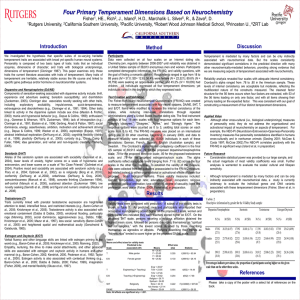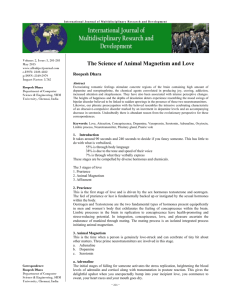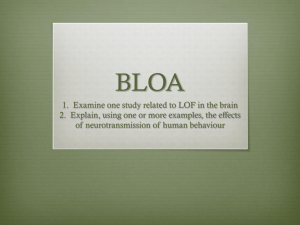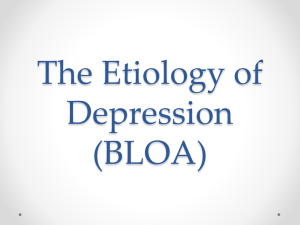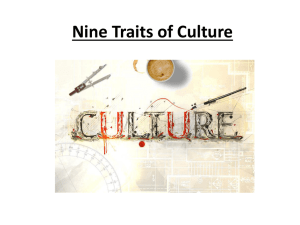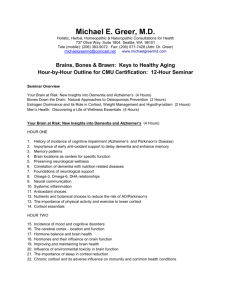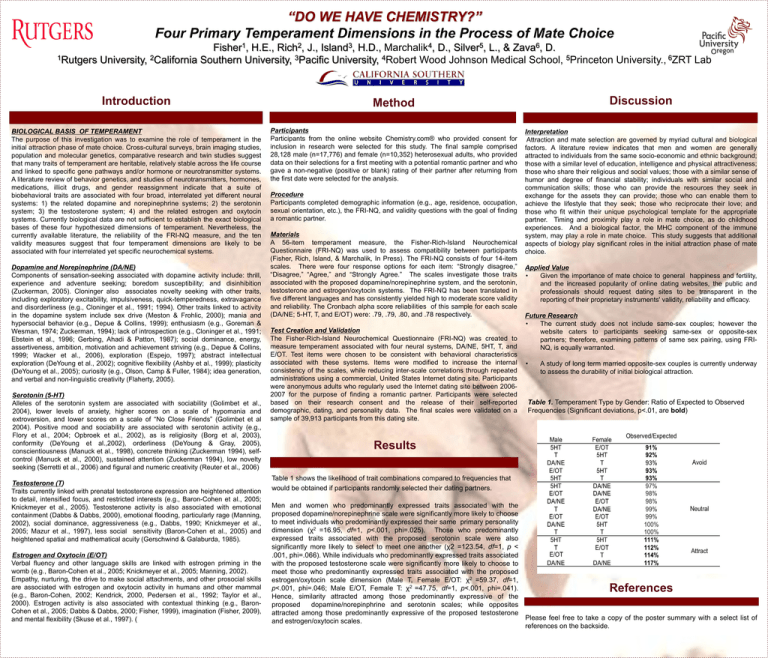
“DO WE HAVE CHEMISTRY?”
Four Primary Temperament Dimensions in the Process of Mate Choice
1
Fisher ,
2
Rich ,
3
Island ,
4
Marchalik ,
5
Silver ,
6
Zava ,
H.E.,
J.,
H.D.,
D.,
L., &
D.
1Rutgers University, 2California Southern University, 3Pacific University, 4Robert Wood Johnson Medical School, 5Princeton University., 6ZRT Lab
Introduction
Method
Discussion
BIOLOGICAL BASIS OF TEMPERAMENT
The purpose of this investigation was to examine the role of temperament in the
initial attraction phase of mate choice. Cross-cultural surveys, brain imaging studies,
population and molecular genetics, comparative research and twin studies suggest
that many traits of temperament are heritable, relatively stable across the life course
and linked to specific gene pathways and/or hormone or neurotransmitter systems.
A literature review of behavior genetics, and studies of neurotransmitters, hormones,
medications, illicit drugs, and gender reassignment indicate that a suite of
biobehavioral traits are associated with four broad, interrelated yet different neural
systems: 1) the related dopamine and norepinephrine systems; 2) the serotonin
system; 3) the testosterone system; 4) and the related estrogen and oxytocin
systems. Currently biological data are not sufficient to establish the exact biological
bases of these four hypothesized dimensions of temperament. Nevertheless, the
currently available literature, the reliability of the FRI-NQ measure, and the ten
validity measures suggest that four temperament dimensions are likely to be
associated with four interrelated yet specific neurochemical systems.
Participants
Participants from the online website Chemistry.com® who provided consent for
inclusion in research were selected for this study. The final sample comprised
28,128 male (n=17,776) and female (n=10,352) heterosexual adults, who provided
data on their selections for a first meeting with a potential romantic partner and who
gave a non-negative (positive or blank) rating of their partner after returning from
the first date were selected for the analysis.
Interpretation
Attraction and mate selection are governed by myriad cultural and biological
factors. A literature review indicates that men and women are generally
attracted to individuals from the same socio-economic and ethnic background;
those with a similar level of education, intelligence and physical attractiveness;
those who share their religious and social values; those with a similar sense of
humor and degree of financial stability; individuals with similar social and
communication skills; those who can provide the resources they seek in
exchange for the assets they can provide; those who can enable them to
achieve the lifestyle that they seek; those who reciprocate their love; and
those who fit within their unique psychological template for the appropriate
partner. Timing and proximity play a role in mate choice, as do childhood
experiences. And a biological factor, the MHC component of the immune
system, may play a role in mate choice. This study suggests that additional
aspects of biology play significant roles in the initial attraction phase of mate
choice.
Dopamine and Norepinephrine (DA/NE)
Components of sensation-seeking associated with dopamine activity include: thrill,
experience and adventure seeking; boredom susceptibility; and disinhibition
(Zuckerman, 2005). Cloninger also associates novelty seeking with other traits,
including exploratory excitability, impulsiveness, quick-temperedness, extravagance
and disorderliness (e.g., Cloninger et al., 1991; 1994). Other traits linked to activity
in the dopamine system include sex drive (Meston & Frohlic, 2000); mania and
hypersocial behavior (e.g., Depue & Collins, 1999); enthusiasm (e.g., Goreman &
Wesman, 1974; Zuckerman, 1994); lack of introspection (e.g., Cloninger et al., 1991;
Ebstein et al., 1996; Gerbing, Ahadi & Patton, 1987); social dominance, energy,
assertiveness, ambition, motivation and achievement striving (e.g., Depue & Collins,
1999; Wacker et al., 2006), exploration (Espejo, 1997); abstract intellectual
exploration (DeYoung et al., 2002); cognitive flexibility (Ashby et al., 1999); plasticity
(DeYoung et al., 2005); curiosity (e.g., Olson, Camp & Fuller, 1984); idea generation,
and verbal and non-linguistic creativity (Flaherty, 2005).
Serotonin (5-HT)
Alleles of the serotonin system are associated with sociability (Golimbet et al.,
2004), lower levels of anxiety, higher scores on a scale of hypomania and
extroversion, and lower scores on a scale of “No Close Friends” (Golimbet et al
2004). Positive mood and sociability are associated with serotonin activity (e.g.,
Flory et al., 2004; Opbroek et al., 2002), as is religiosity (Borg et al, 2003),
conformity (DeYoung et al.,2002), orderliness (DeYoung & Gray, 2005),
conscientiousness (Manuck et al., 1998), concrete thinking (Zuckerman 1994), selfcontrol (Manuck et al., 2000), sustained attention (Zuckerman 1994), low novelty
seeking (Serretti et al., 2006) and figural and numeric creativity (Reuter et al., 2006)
Testosterone (T)
Traits currently linked with prenatal testosterone expression are heightened attention
to detail, intensified focus, and restricted interests (e.g., Baron-Cohen et al., 2005;
Knickmeyer et al., 2005). Testosterone activity is also associated with emotional
containment (Dabbs & Dabbs, 2000), emotional flooding, particularly rage (Manning,
2002), social dominance, aggressiveness (e.g., Dabbs, 1990; Knickmeyer et al.,
2005; Mazur et al., 1997), less social sensitivity (Baron-Cohen et al., 2005) and
heightened spatial and mathematical acuity (Gerschwind & Galaburda, 1985).
Estrogen and Oxytocin (E/OT)
Verbal fluency and other language skills are linked with estrogen priming in the
womb (e.g., Baron-Cohen et al., 2005; Knickmeyer et al., 2005; Manning, 2002).
Empathy, nurturing, the drive to make social attachments, and other prosocial skills
are associated with estrogen and oxytocin activity in humans and other mammal
(e.g., Baron-Cohen, 2002; Kendrick, 2000, Pedersen et al., 1992; Taylor et al.,
2000). Estrogen activity is also associated with contextual thinking (e.g., BaronCohen et al., 2005; Dabbs & Dabbs, 2000; Fisher, 1999), imagination (Fisher, 2009),
and mental flexibility (Skuse et al., 1997). (
Procedure
Participants completed demographic information (e.g., age, residence, occupation,
sexual orientation, etc.), the FRI-NQ, and validity questions with the goal of finding
a romantic partner.
Materials
A 56-item temperament measure, the Fisher-Rich-Island Neurochemical
Questionnaire (FRI-NQ) was used to assess compatibility between participants
(Fisher, Rich, Island, & Marchalik, In Press). The FRI-NQ consists of four 14-item
scales. There were four response options for each item: “Strongly disagree,”
“Disagree,” “Agree,” and “Strongly Agree.” The scales investigate those traits
associated with the proposed dopamine/norepinephrine system, and the serotonin,
testosterone and estrogen/oxytocin systems. The FRI-NQ has been translated in
five different languages and has consistently yielded high to moderate score validity
and reliability. The Cronbach alpha score reliabilities of this sample for each scale
(DA/NE; 5-HT, T, and E/OT) were: .79, .79, .80, and .78 respectively.
Test Creation and Validation
The Fisher-Rich-Island Neurochemical Questionnaire (FRI-NQ) was created to
measure temperament associated with four neural systems, DA/NE, 5HT, T, and
E/OT. Test items were chosen to be consistent with behavioral characteristics
associated with these systems. Items were modified to increase the internal
consistency of the scales, while reducing inter-scale correlations through repeated
administrations using a commercial, United States Internet dating site. Participants
were anonymous adults who regularly used the Internet dating site between 20062007 for the purpose of finding a romantic partner. Participants were selected
based on their research consent and the release of their self-reported
demographic, dating, and personality data. The final scales were validated on a
sample of 39,913 participants from this dating site.
Applied Value
•
Given the importance of mate choice to general happiness and fertility,
and the increased popularity of online dating websites, the public and
professionals should request dating sites to be transparent in the
reporting of their proprietary instruments' validity, reliability and efficacy.
Future Research
•
The current study does not include same-sex couples; however the
website caters to participants seeking same-sex or opposite-sex
partners; therefore, examining patterns of same sex pairing, using FRINQ, is equally warranted.
•
A study of long term married opposite-sex couples is currently underway
to assess the durability of initial biological attraction.
Table 1. Temperament Type by Gender: Ratio of Expected to Observed
Frequencies (Significant deviations, p<.01, are bold)
Results
Table 1 shows the likelihood of trait combinations compared to frequencies that
would be obtained if participants randomly selected their dating partners.
Men and women who predominantly expressed traits associated with the
proposed dopamine/norepinephrine scale were significantly more likely to choose
to meet individuals who predominantly expressed their same primary personality
dimension (χ2 =16.95, df=1, p<.001, phi=.025). Those who predominantly
expressed traits associated with the proposed serotonin scale were also
significantly more likely to select to meet one another (χ2 =123.54, df=1, p <
.001, phi=.066). While individuals who predominantly expressed traits associated
with the proposed testosterone scale were significantly more likely to choose to
meet those who predominantly expressed traits associated with the proposed
estrogen/oxytocin scale dimension (Male T, Female E/OT: χ2 =59.37, df=1,
p<.001, phi=.046; Male E/OT, Female T: χ2 =47.75, df=1, p<.001, phi=.041).
Hence, similarity attracted among those predominantly expressive of the
proposed
dopamine/norepinphrine and serotonin scales; while opposites
attracted among those predominantly expressive of the proposed testosterone
and estrogen/oxytocin scales.
References
Please feel free to take a copy of the poster summary with a select list of
references on the backside.

